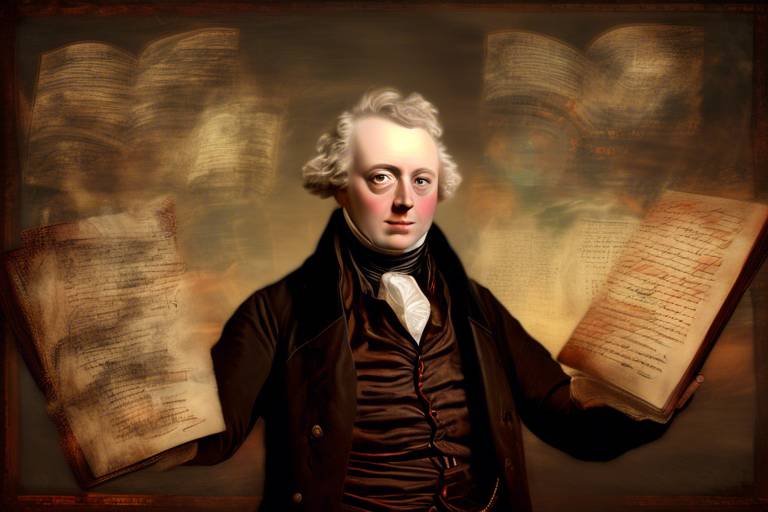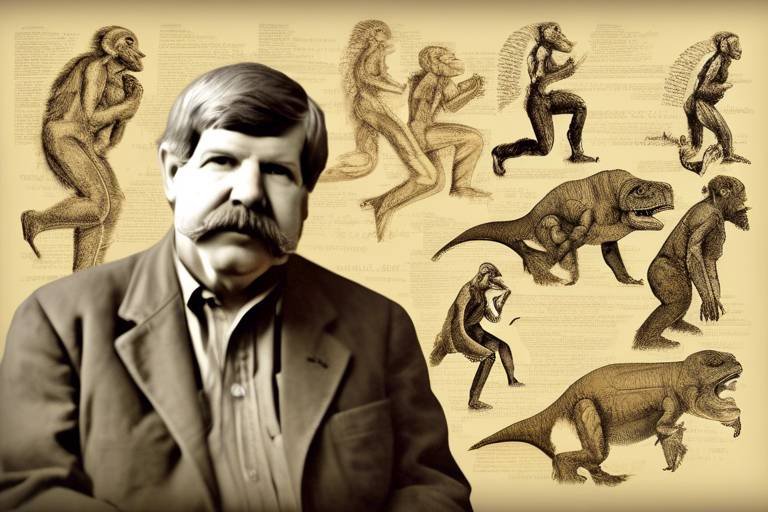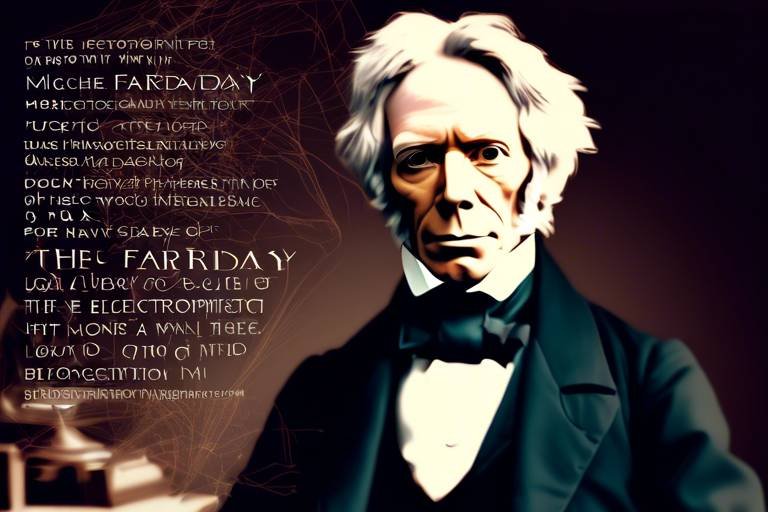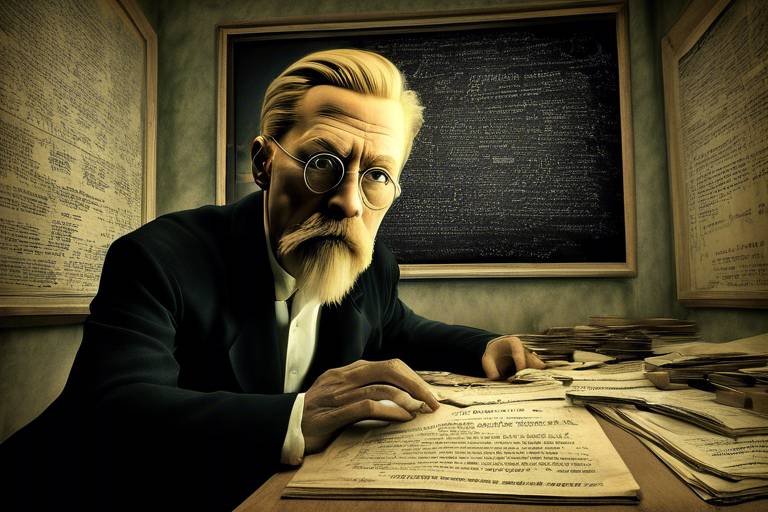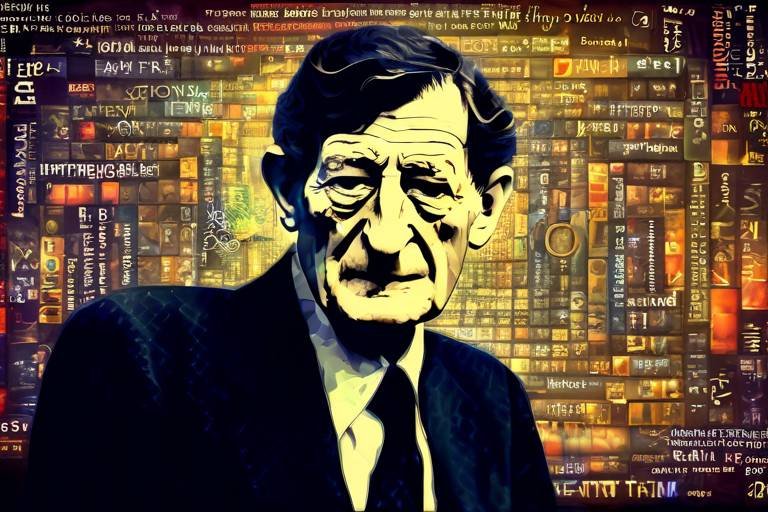The Contributions of Thomas Young to Wave Theory
When we think about the history of physics, certain names shine brighter than others, and Thomas Young is undoubtedly one of them. His contributions to wave theory not only transformed our understanding of light but also laid the groundwork for numerous technological advancements. Imagine a world where the behavior of light was still a mystery; Young’s work illuminated the path forward, much like a lighthouse guiding ships through foggy waters. This article delves into the significant advancements made by Young in the field of wave theory, highlighting his experiments, theories, and the lasting impact they have had on physics and optics.
One of Young's most famous contributions is the double-slit experiment, a simple yet profound demonstration that showcased the wave nature of light. Picture this: when light passes through two closely spaced slits, it creates an interference pattern on a screen behind the slits. This pattern, characterized by alternating bright and dark fringes, is a clear indication of light behaving as a wave. Before Young's experiment, the dominant theory was that light was made up of particles, but his findings challenged this notion, leading to a pivotal shift in scientific understanding. The beauty of this experiment lies in its simplicity and the profound implications it carries, proving that light can indeed behave like a wave, a revelation that has echoed through the ages.
Building on the double-slit experiment, Young introduced the concept of light interference, which occurs when two or more light waves overlap. This phenomenon can be likened to a dance where the waves either come together to create a stronger effect or cancel each other out, depending on their phase relationship. Understanding this concept is crucial because it forms the basis for many optical technologies we rely on today. For instance, the very screens we use to view images and videos are often designed with interference effects in mind, showcasing the practical implications of Young's groundbreaking work.
Young meticulously detailed the principles of constructive and destructive interference. Constructive interference occurs when waves meet in phase, amplifying the resultant wave, while destructive interference happens when waves are out of phase, reducing the overall effect. These principles are not just academic; they have real-world applications in fields like acoustics, optics, and telecommunications. For example, in acoustics, sound engineers use these principles to create environments with optimal sound quality, demonstrating how Young's findings continue to resonate in modern technology.
The understanding of interference has led to significant advancements in various technologies. Here are some key applications:
- Lasers: The principles of interference are fundamental in the operation of lasers, which have applications ranging from medicine to telecommunications.
- Fiber Optics: Interference effects are crucial in the design of fiber optic systems, enabling high-speed internet and communication.
- Imaging Systems: Techniques such as holography rely on interference patterns to create three-dimensional images.
Young's innovative experimental techniques laid the groundwork for future experiments in wave theory. His methods were not only groundbreaking but also set a standard for how scientists conduct research in optics and other wave-related fields. By emphasizing the importance of meticulous observation and experimentation, Young inspired generations of physicists to explore the mysteries of light and waves.
In addition to his experimental contributions, Young also provided mathematical formulations that describe wave behavior. His equations offer a quantitative framework for analyzing wave interactions and phenomena across various scientific disciplines. This mathematical rigor is essential for scientists and engineers who seek to harness the power of waves in their work, making Young's contributions invaluable to both theoretical and applied physics.
Beyond wave theory, Young made significant contributions to the field of optics, particularly in the study of color and vision. His explorations into the nature of light and its interaction with the human eye enriched our understanding of visual perception. Young’s work is a testament to the interconnectedness of scientific disciplines, illustrating how discoveries in one area can illuminate others.
Young's investigations into color theory explored how we perceive color and the role that different wavelengths of light play in this process. His findings laid the foundation for modern color science, influencing everything from art to technology. By understanding how light wavelengths correspond to different colors, we can appreciate the vibrancy of our world and even manipulate colors in various applications.
Furthermore, by delving into how the human eye perceives light, Young contributed to our understanding of visual perception. His insights have had lasting implications not only in physics but also in psychology and physiological optics. Understanding how we see the world enriches our experience and informs various fields, from design to neuroscience.
- What is the double-slit experiment? The double-slit experiment is a demonstration that shows light can behave as both a particle and a wave, revealing the wave nature of light through interference patterns.
- Why is Thomas Young important in physics? Thomas Young is crucial in physics for his pioneering work in wave theory, particularly his double-slit experiment, which challenged existing notions about light.
- How did Young influence modern technology? Young's principles of interference have led to advancements in lasers, fiber optics, and imaging systems, which are integral to modern communication and technology.

Young's Double-Slit Experiment
Thomas Young's double-slit experiment is often regarded as one of the most profound demonstrations in the history of physics. Conducted in 1801, this experiment was not just a simple test; it was a pivotal moment that challenged the way we understand light. Imagine standing on a beach, watching waves crash against the shore. Now, picture those waves passing through two openings in a barrier. As they emerge on the other side, they spread out and interact with each other, creating a mesmerizing pattern of peaks and troughs. This is the essence of what Young discovered.
When light passes through two closely spaced slits, it doesn't merely travel in straight lines. Instead, it behaves like a wave, producing an interference pattern on a screen placed behind the slits. This pattern consists of alternating bright and dark fringes, a clear indication that light waves are overlapping and interacting. The bright areas occur where the waves reinforce each other (constructive interference), while the dark areas appear where they cancel each other out (destructive interference). This observation was revolutionary, as it provided compelling evidence against the prevailing particle theory of light at the time.
Young's experiment can be summarized in a few key steps:
- Light from a coherent source, like a candle or a lamp, is directed at a barrier with two narrow slits.
- As light passes through the slits, it spreads out and overlaps.
- On a screen behind the slits, an interference pattern is observed, characterized by alternating bright and dark bands.
This simple yet elegant setup led to profound implications. Young's findings suggested that light behaves as a wave, a notion that laid the groundwork for the development of wave theory. It also opened the door to a deeper understanding of the nature of light and its dual wave-particle behavior, a cornerstone of modern physics.
Moreover, the double-slit experiment has transcended its original context. It has become a fundamental demonstration used in various fields, from quantum mechanics to optics. Scientists continue to reference this experiment as they explore the wave-particle duality of light, emphasizing its significance in the broader scope of physics.
In essence, Young's double-slit experiment was not just about light; it was a gateway to understanding the universe. It showed us that reality is often more complex and mysterious than it appears, challenging our perceptions and inviting us to delve deeper into the laws of nature.

Interference of Light Waves
The phenomenon of light interference is one of the most fascinating aspects of wave theory, and it all began with the visionary experiments of Thomas Young. Imagine standing on a beach, watching the waves crash against the shore. Sometimes, two waves come together and create a larger wave, while at other times, they seem to cancel each other out. This is precisely what happens with light waves, and Young's experiments illuminated this concept brilliantly.
When two or more light waves overlap, they can interact in ways that either enhance or diminish their intensity. This interaction leads to what we call interference, which can be categorized into two main types: constructive interference and destructive interference. In constructive interference, the peaks of one wave align with the peaks of another, resulting in a wave of greater amplitude. Conversely, in destructive interference, the peak of one wave aligns with the trough of another, leading to a reduction in overall intensity.
To visualize this, consider the following table that summarizes the characteristics of each type of interference:
| Type of Interference | Description | Resulting Effect |
|---|---|---|
| Constructive Interference | Occurs when waves align in phase | Increased amplitude |
| Destructive Interference | Occurs when waves align out of phase | Decreased amplitude |
The implications of these principles extend far beyond the laboratory. Understanding how light waves can interfere with one another is crucial in various fields, including acoustics, optics, and telecommunications. For instance, in acoustics, the principle of interference explains why certain musical notes sound richer when played together, while in telecommunications, it helps engineers design systems that minimize signal loss.
Young's exploration of light interference not only challenged the existing particle theory of light but also opened up a new realm of possibilities in optical technologies. Think about the devices we use every day, from lasers to fiber optics; they all rely on the principles of light interference to function effectively. The ability to manipulate light waves has led to innovations that have transformed industries and enhanced our daily lives.
In conclusion, the interference of light waves, as demonstrated by Thomas Young, is not just a scientific curiosity but a foundational concept that underpins much of modern technology. By studying how waves interact, we gain insights that propel scientific advancements and enrich our understanding of the universe.
- What is light interference? Light interference is the phenomenon that occurs when two or more light waves overlap, leading to variations in their intensity due to constructive or destructive interference.
- Why is Thomas Young's double-slit experiment important? Young's double-slit experiment provided crucial evidence for the wave nature of light, demonstrating how light waves can create interference patterns.
- How does interference affect modern technology? Interference principles are fundamental in technologies such as lasers, fiber optics, and imaging systems, impacting various industries and applications.

Constructive and Destructive Interference
When we dive into the world of waves, one of the most fascinating concepts that emerges is interference. Imagine two boats bobbing on the ocean, each creating its own set of waves. When these waves meet, they can either combine to form a larger wave or cancel each other out. This is the essence of what Thomas Young described as , a phenomenon that plays a crucial role in understanding how waves interact with one another.
To break it down, constructive interference occurs when two waves meet in phase, meaning their peaks align perfectly. This alignment amplifies the wave, leading to a wave of greater amplitude. Think of it as two singers harmonizing—when their voices blend perfectly, the sound is richer and more powerful. Mathematically, this can be represented as:
| Wave 1 | Wave 2 | Resultant Wave |
|---|---|---|
| A sin(ωt) | B sin(ωt) | R A + B 2sin(ωt) |
On the flip side, we have destructive interference, which occurs when waves meet out of phase—think of one wave's peak meeting another wave's trough. This results in a cancellation effect, reducing the overall amplitude. Imagine two people pushing a swing in opposite directions; their efforts counteract each other, leading to no movement at all. This can be expressed mathematically as:
| Wave 1 | Wave 2 | Resultant Wave |
|---|---|---|
| A sin(ωt) | B -sin(ωt) | R A + B 0 |
Understanding these principles is not just an academic exercise; they have real-world applications. For example, in acoustics, the design of concert halls relies on constructive interference to enhance sound quality, while noise-canceling headphones utilize destructive interference to eliminate unwanted sounds. Young's pioneering work in this area has paved the way for countless innovations across various fields.
In summary, the concepts of constructive and destructive interference are fundamental to wave theory. They help us grasp how waves interact in the physical world, influencing everything from sound to light. By recognizing the patterns of these interactions, we can better understand the technologies that shape our daily lives.
- What is the difference between constructive and destructive interference?
Constructive interference occurs when waves align in phase, amplifying the resultant wave, while destructive interference occurs when waves are out of phase, canceling each other out. - How does interference affect sound quality?
Constructive interference can enhance sound quality in spaces designed for acoustics, while destructive interference can be used in noise-canceling technologies to reduce unwanted noise. - Can interference be observed in light waves?
Yes, interference is a key concept in optics, as demonstrated by Young's double-slit experiment, which shows light behaving as a wave, creating patterns of constructive and destructive interference.

Applications in Modern Technology
Thomas Young's groundbreaking discoveries in wave theory have paved the way for numerous applications in modern technology that permeate our daily lives. From the moment you turn on your smartphone to the time you enjoy a laser light show, you're witnessing the profound impact of his work. Understanding interference and the wave nature of light has led to innovations that have revolutionized various industries.
One of the most significant applications is in the field of fiber optics. By utilizing the principles of light interference, fiber optic technology allows for the transmission of data at incredible speeds over long distances. This technology is the backbone of modern telecommunications, enabling high-speed internet and seamless communication across the globe. Imagine sending a message that travels faster than the blink of an eye—this is the reality made possible by Young’s contributions.
Another remarkable application is found in laser technology. Lasers operate on the principle of stimulated emission, which is closely related to interference patterns. These devices are used in various fields, from medical procedures like LASIK eye surgery to industrial applications such as cutting and welding materials. The precision and efficiency of lasers can be directly traced back to the foundational concepts introduced by Young, demonstrating how theoretical physics can lead to practical, life-changing technologies.
Furthermore, Young's work has influenced the development of imaging systems. Techniques such as holography rely heavily on the interference of light waves to create three-dimensional images. This technology finds applications in security (like holographic stickers), data storage, and even art. The ability to capture and reproduce images in such detail enhances our visual experiences and opens up new avenues for creativity.
To summarize, the applications of Thomas Young's contributions to wave theory are vast and varied. They not only highlight the importance of scientific inquiry but also illustrate how foundational research can lead to extraordinary advancements that shape our world. As we continue to explore and innovate, the legacy of Young’s work serves as a reminder of the power of understanding the natural phenomena around us.
| Application | Description | Impact |
|---|---|---|
| Fiber Optics | Utilizes light interference for data transmission. | Enables high-speed internet and global communication. |
| Laser Technology | Operates on principles of light interference. | Used in medical, industrial, and consumer applications. |
| Imaging Systems | Employs interference to create 3D images. | Enhances security, data storage, and artistic expression. |
- What is Thomas Young known for?
Thomas Young is best known for his work on wave theory, particularly the double-slit experiment, which demonstrated the wave nature of light. - How did Young's experiments influence modern technology?
Young's experiments laid the groundwork for technologies such as fiber optics, lasers, and imaging systems, which are integral to communications and medical fields today. - What is the significance of interference in optics?
Interference is crucial in optics as it explains how light waves interact, leading to various phenomena and applications in modern technology.

Experimental Techniques
Thomas Young's innovative were nothing short of revolutionary in the field of wave theory. His approach not only challenged existing notions about light but also set a new standard for scientific experimentation. One of the most notable techniques he employed was the use of the double-slit apparatus. This simple yet elegant setup allowed him to observe the behavior of light in a way that had never been done before. By shining light through two closely spaced slits, Young was able to produce an interference pattern on a screen behind the slits, which was a clear indication of the wave nature of light. It was as if he opened a door to a hidden realm, revealing the intricate dance of light waves.
Young's method of conducting experiments was characterized by meticulous attention to detail. He understood that the reproducibility of results was crucial for validating his theories. Therefore, he often repeated experiments multiple times, ensuring that his findings were consistent. This practice not only solidified his conclusions but also laid the groundwork for future physicists to build upon. The double-slit experiment itself has been replicated countless times since Young's original work, demonstrating its significance and reliability.
Moreover, Young's techniques went beyond just the double-slit experiment. He also explored the effects of light diffraction, which occurs when light waves encounter an obstacle or aperture. By using various materials and slits of different widths, he was able to observe how light waves spread out and interfere with one another. This exploration into diffraction added another layer to our understanding of wave behavior and further illustrated the complexity of light.
Young's work didn't stop at just light; he also applied his experimental techniques to sound waves, demonstrating that the principles of interference were universal across different types of waves. In doing so, he highlighted the interconnectedness of various scientific fields, showing that the same fundamental principles could explain phenomena in both acoustics and optics. This holistic approach was groundbreaking and encouraged other scientists to adopt similar methodologies in their own research.
In summary, Thomas Young's experimental techniques were pivotal in shaping the study of wave theory. His rigorous methods, coupled with his innovative use of the double-slit experiment and exploration of diffraction, not only provided compelling evidence for the wave nature of light but also influenced generations of scientists. The legacy of his techniques continues to resonate in modern physics, reminding us of the importance of careful experimentation and observation in the pursuit of knowledge.
- What was the significance of Young's double-slit experiment?
Young's double-slit experiment demonstrated the wave nature of light, providing crucial evidence that challenged the particle theory of light. - How did Young contribute to the understanding of color?
Young's research on color theory laid the groundwork for modern color science by explaining how light wavelengths affect color perception. - What other fields did Young's techniques impact?
Young's experimental techniques influenced not only optics but also fields like acoustics and telecommunications by demonstrating the universal principles of wave behavior.

Mathematical Formulation
When we talk about Thomas Young, we can't overlook his remarkable mathematical formulations that revolutionized our understanding of wave behavior. Young didn't just stop at demonstrating wave interference; he provided the mathematical backbone that allows scientists to analyze and predict wave interactions. His work laid the groundwork for what we now call wave mechanics, a crucial area in both physics and engineering.
At the heart of Young's contributions is the wave equation, which describes how waves propagate through different media. This equation is essential for understanding various phenomena, from sound waves traveling through air to light waves moving through a vacuum. The general form of the wave equation is:
∂²u/∂t² c² ∂²u/∂x²
In this equation, u represents the wave function, c is the speed of the wave, and the symbols indicate how the wave changes over time and space. Young's ability to translate physical concepts into mathematical language helped pave the way for future discoveries in wave theory and optics.
Moreover, Young's interference patterns can be quantified using trigonometric functions. When two waves of the same frequency and amplitude overlap, their resulting wave can be represented mathematically. The condition for constructive interference, where waves amplify each other, occurs when the path difference between the waves is an integer multiple of their wavelength:
Δd nλ (where n 0, 1, 2, ...)
Conversely, destructive interference happens when the path difference is a half-integer multiple of the wavelength:
Δd (n + 0.5)λ
This mathematical formulation is not just a theoretical exercise; it has real-world applications in technologies like lasers and fiber optics. By understanding these principles, engineers can design systems that manipulate light in ways that were previously unimaginable.
In summary, Young's mathematical contributions provided a robust framework for understanding wave phenomena. His equations and principles are still fundamental in modern physics, proving that the legacy of his work continues to influence new generations of scientists and engineers. The beauty of mathematics lies in its ability to describe the universe, and Young's work exemplifies this perfectly.
- What was Thomas Young's most famous experiment?
Young's most famous experiment is the double-slit experiment, which demonstrated the wave nature of light through interference patterns.
- How did Young contribute to color theory?
Young's experiments on color perception led to the formulation of the trichromatic theory of color vision, which explains how humans perceive colors through three types of cones in the eye.
- Why is Young's work still relevant today?
Young's contributions laid the foundation for modern optics and wave theory, influencing technologies such as lasers, fiber optics, and imaging systems.

Young's Contributions to Optics
Thomas Young was not just a pioneer in wave theory; he also made significant strides in the field of optics. His explorations into how light interacts with matter have profoundly influenced our understanding of light and its properties. One of Young's most notable contributions was his investigation into the nature of color and how we perceive it. Imagine standing in a room filled with various colors, each one evoking a different emotion. Young's work helped to decode this intricate relationship between light and color, laying the groundwork for modern color science.
Young's experiments revealed that color perception is linked to the wavelengths of light. He proposed that the human eye perceives color through three types of receptors, which correspond to the primary colors: red, green, and blue. This three-color theory of vision was revolutionary, as it explained how different combinations of these colors could produce the full spectrum of visible light. To illustrate this, consider the way a painter mixes colors on a palette; the right combination can create a vibrant masterpiece, much like how our eyes blend light waves to perceive the world around us.
Furthermore, Young delved into the mechanics of vision itself. He studied how light enters the eye, focusing on the lens and retina, and how these components work together to form images. His findings contributed significantly to the fields of psychology and physiological optics, as they provided insights into how the brain interprets visual information. The human eye is often likened to a camera, capturing images and sending them to the brain for processing. Young's research helped to refine this analogy, showing that the eye's ability to focus and adjust is akin to a photographer adjusting their lens to capture the perfect shot.
Young's contributions to optics can be summarized in several key areas:
- Color Theory: His exploration of how light wavelengths affect color perception.
- Visual Perception: Investigating the mechanics of how we see and interpret light.
- Influence on Modern Science: His work laid the foundation for future research in optics and vision science.
In addition to these contributions, Young's innovative approach to experimentation set a high standard for scientific inquiry. He meticulously documented his findings, ensuring that future generations of scientists could build upon his work. His legacy is not just in the theories he proposed but also in the rigorous methods he employed, which continue to influence research in optics today. The impact of Young's work is evident in various modern technologies, from cameras and projectors to advanced imaging systems used in medicine and industry.
In summary, Thomas Young's contributions to optics have had a lasting impact on both science and technology. His pioneering work in color theory and visual perception not only enhanced our understanding of light but also paved the way for advancements in various fields. Young's legacy serves as a reminder of the importance of curiosity and innovation in the pursuit of knowledge.
Q: What was Thomas Young's most famous experiment?
A: Young's most famous experiment is the double-slit experiment, which demonstrated the wave nature of light.
Q: How did Young contribute to our understanding of color?
A: Young proposed the three-color theory of vision, explaining how the human eye perceives color through three types of receptors sensitive to red, green, and blue light.
Q: Why are Young's contributions important today?
A: Young's work laid the foundation for modern optics and color science, influencing technologies such as cameras, televisions, and medical imaging systems.

Color Theory
Thomas Young's exploration of was nothing short of revolutionary. He was one of the first to delve into the intricacies of how we perceive color, laying the groundwork for our modern understanding of light and vision. Young proposed that color perception arises from the interaction of light waves with the human eye, which contains specialized cells sensitive to different wavelengths. This idea was pivotal, as it shifted the perspective from a purely physical understanding of light to a more psychological one, emphasizing the role of human perception.
To illustrate his theory, Young introduced the concept of the trichromatic theory of color vision. According to this theory, the human eye contains three types of color receptors, which are sensitive to short (blue), medium (green), and long (red) wavelengths of light. When light enters the eye, these receptors respond to the different wavelengths, and the brain interprets this information to produce the perception of color. This fundamental understanding can be summarized in the following table:
| Color | Wavelength (nm) | Receptor Type |
|---|---|---|
| Blue | 450 | Short |
| Green | 550 | Medium |
| Red | 650 | Long |
This table not only highlights the primary colors but also emphasizes how our perception of color is a complex interplay of light and biology. Young's findings laid the foundation for further studies in color science and visual perception, influencing fields ranging from art to technology. His work helped explain why certain colors blend well together while others clash, a principle that is still widely used in design and visual arts today.
Moreover, Young's research into color perception extended to the understanding of color blindness. By examining how some individuals perceive colors differently, he contributed to the knowledge that certain color deficiencies arise from the absence or malfunction of specific cone cells in the retina. This insight not only advanced the field of optics but also had profound implications for psychology and the study of human vision.
In summary, Thomas Young's contributions to color theory were groundbreaking. His trichromatic theory not only explained how we perceive color but also paved the way for future research in both the sciences and the arts. Young's ability to connect the dots between physics and human perception exemplifies the kind of interdisciplinary thinking that drives innovation. As we continue to explore the complexities of light and color, we owe a significant debt to Young's pioneering work.
- What is the trichromatic theory of color vision?
The trichromatic theory posits that the human eye has three types of color receptors sensitive to different wavelengths of light, which combine to produce the perception of color. - How did Thomas Young contribute to the understanding of color blindness?
Young's research into color perception helped explain that color blindness can result from the absence or malfunction of specific cone cells in the retina. - Why is Young's work in color theory important?
His findings laid the foundation for modern color science and influenced various fields, including art, design, and psychology.

Vision and Perception
Thomas Young's investigations into were groundbreaking, paving the way for a deeper understanding of how we interact with light. He delved into the intricate workings of the human eye, exploring how it perceives color and light intensity. Imagine your eye as a tiny camera, capturing the vibrant world around you. Young's work helped to decode the complex process behind this 'capturing' and laid the groundwork for modern visual perception studies.
One of Young's major contributions was his exploration of the trichromatic theory of color vision. This theory posits that the human eye has three types of color receptors, each sensitive to different wavelengths of light. To illustrate this concept, consider the following table that summarizes the three types of cones in our eyes:
| Type of Cone | Wavelength Sensitivity | Color Perception |
|---|---|---|
| S-cones | Short wavelengths (blue) | Blue |
| M-cones | Medium wavelengths (green) | Green |
| L-cones | Long wavelengths (red) | Red |
This table highlights how each type of cone contributes to our overall perception of color. Young's research demonstrated that the combination of signals from these three types of cones allows us to perceive a wide spectrum of colors, much like mixing paints to create new shades. Without this foundational understanding, our comprehension of color vision would be significantly limited.
Moreover, Young's studies extended beyond just color perception. He also examined how the eye perceives brightness and contrast, which are crucial for visual clarity. Think about it: when you enter a dimly lit room, your eyes take a moment to adjust. This adjustment is a result of complex physiological processes that Young sought to explain. He highlighted how the human visual system adapts to varying light conditions, ensuring that we can navigate our environment effectively.
In addition to his contributions to color theory, Young's work influenced various fields, including psychology and physiological optics. His findings laid the groundwork for understanding how visual perception can be affected by factors such as lighting conditions and background contrast. For example, have you ever noticed how a white shirt looks different under the harsh sunlight compared to a soft, indoor light? This phenomenon can be attributed to the principles Young studied.
Furthermore, Young's insights into vision and perception have practical applications in modern technology. From digital displays to optical instruments, his work continues to resonate in the design and functionality of various devices that rely on our understanding of light and vision. Without Young's pioneering research, many of these advancements might not have been possible.
In summary, Thomas Young's contributions to the study of vision and perception are as vital as they are fascinating. His exploration of how we perceive color and light not only enriched the scientific community's understanding but also had a lasting impact on various disciplines. As we continue to explore the realms of vision science, we owe a significant debt to Young's pioneering work that opened the door to a clearer understanding of the world around us.
- What is Thomas Young best known for?
Thomas Young is best known for his double-slit experiment and contributions to the wave theory of light, as well as his work on color vision and perception. - How did Young's double-slit experiment impact science?
The double-slit experiment provided crucial evidence for the wave nature of light, challenging the existing particle theory and influencing the development of modern physics. - What is the trichromatic theory of color vision?
The trichromatic theory posits that the human eye has three types of color receptors (cones) sensitive to different wavelengths of light, allowing us to perceive a wide range of colors. - How has Young's work influenced modern technology?
Young's research laid the groundwork for advancements in optical technologies, such as lasers, fiber optics, and imaging systems, which rely on our understanding of light and vision.
Frequently Asked Questions
- What is Thomas Young's double-slit experiment?
Thomas Young's double-slit experiment is a famous demonstration that illustrates the wave nature of light. In this experiment, light is shone through two closely spaced slits, resulting in an interference pattern on a screen behind the slits. This pattern, consisting of alternating bright and dark fringes, provides compelling evidence that light behaves as a wave, challenging the earlier particle theory of light.
- How does interference of light waves work?
Interference of light waves occurs when two or more overlapping light waves combine. Depending on their phase relationship, they can either amplify each other (constructive interference) or cancel each other out (destructive interference). This phenomenon is essential for understanding various optical technologies, like lasers and fiber optics, and is a fundamental concept in wave theory.
- What are constructive and destructive interference?
Constructive interference happens when waves align in phase, resulting in a wave of greater amplitude. On the other hand, destructive interference occurs when waves are out of phase, leading to a reduction in amplitude or complete cancellation. These principles are crucial in multiple fields, including acoustics, telecommunications, and optics.
- What are the practical applications of Young's findings?
Young's contributions to wave theory and interference have led to significant advancements in modern technology. Applications include lasers used in medicine and communications, fiber optics for high-speed internet, and various imaging systems that rely on wave behavior to produce clear images.
- What experimental techniques did Young introduce?
Thomas Young's innovative experimental techniques, particularly in his double-slit experiment, set a standard for future research in wave theory. His methods emphasized the importance of precise measurements and controls, influencing how scientists conduct experiments in optics and related fields.
- What mathematical formulations did Young contribute to wave theory?
Young contributed to the mathematical understanding of wave behavior by developing equations that describe wave interactions. His formulations provided a quantitative framework for analyzing phenomena like interference and diffraction, which are essential in various scientific disciplines.
- What are Young's contributions to color theory?
In addition to his work in wave theory, Thomas Young made significant contributions to color theory. He explored how the human eye perceives color and the role of different light wavelengths, laying the groundwork for modern color science and our understanding of visual perception.
- How did Young influence the study of vision and perception?
Young's investigations into how the human eye perceives light significantly influenced both psychology and physiological optics. His research helped explain the mechanisms of visual perception, enhancing our understanding of how we interpret the world around us.

